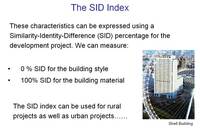- England
- Scotland
- France
- Holland
- Germany
- Italy
- Spain
- Portugal
- USA
- China
- Japan
- India
- Iran
- Advice
- Gardens
- England
- Scotland
- France
- Holland
- Germany
- Italy
- Spain
- Portugal
- USA
- China
- Japan
- India
- Iran
- Advice
- Garden Tours
Book: Landscape Planning and Environmental Impact Design: from EIA to EID
Chapter: Chapter 3 Context sensitive design theory
An index can be used to define the extent to which development projects will be Similar to, Different from or Identical with their context. The foregoing theories of context treat 'the environment' in different ways: aesthetic, ecological and social. The list is incomplete, but from each standpoint the relationship between a development and its context can be one of Similarity, Identity or Difference. Logically, these are the only possibilities. Yet a project can be Identical in one respect and Different in others, as when a skyscraper is faced in a local stone. An Identity Index, using a percentage scale, is a good way of describing the degree of Similarity, Identity or Difference between a development and an aspect of the environment. For example: Materials SizeStyle Vegetation Tower Block90% 20%10% 30% This example shows Identity values for a stone-clad tower block in an historic stone-built town. They range from 90% identity for building materials to 10% identity for architectural style. 'Vegetation' is given a score of 30%, reflecting the proportion of native shrubs to exotic shrubs. Total identity between a development and its environment is unusual, though one could get close by using identical materials in identical shapes and patterns, as when an area of disturbed ground is resown with seed gathered from the surrounding area. In time, this could produce 100% identity. When a gap appeared in a row of Georgian houses it was once fashionable to carry out what was know as 'sympathetic infill' using similar materials and similar shapes but in a modern idiom. Such projects might have an average Identity Index of 90%. A low Identity Index would result from using unrelated materials, shapes and patterns, as in [Fig 3.17]. Project teams can be asked to state an Identity Index for development proposals and for the separate aspects of their proposals. Indeed, if I were drafting a planning or Environmental Assessment law, I would insert a requirement that every application for approval must be accompanied by a statement giving an Identity Index for components and for the overall project. There should also be a reasoned account of how the decisions were taken. In a conservation area, the average Identity Index of development projects should be weighted towards 'very close resemblance'. In a major re-development area, we could expect most of the projects to be Different from the existing environment but related to each other. At La D�fense, in Paris , this was achieved by encouraging tall buildings and by projecting the grand avenue from the Louvre and the Arc de Triomphe into the development area [Fig 3.18]. In London 's Isle of Dogs [Fig 3.19], there is hardly any visual similarity between the buildings, but conservation of the water bodies has created a spatial pattern which is similar to the pre-development landscape. A new reservoir in a beautiful place should be similar to other water bodies in the region. It was right to make the Sydney Opera House different from all surrounding buildings - and to give it a kinship with the sailing ships which pass by. These examples illustrate different Identity policies. Each has its place, but design teams should be required to explain the stance they have taken on the various aspects of identity between development and environment. Each contextual relationship requires the support of a coherent argument. Projects must be designed 'from the outside in' and 'from the inside out'. Use of an Identity Index need not be a factor in deciding for or against the Australian's application for a church and Eucalypt forest. It would merely define the background against which his justification of the proposed contextual relationship would have to be developed.
